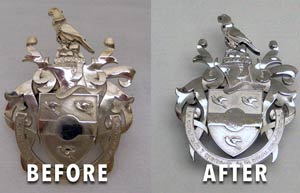Electroplating can be defined as the deposit of a very thin layer of metal “electrolytically” to a base metal to enhance or change its appearance. Electroplating is done in a liquid solution called an electrolyte (fig. a ), also known as a “plating bath”. The plating bath is a specially designed chemical bath that has the desired metal (i.e. silver, gold) dissolved as microscopic particles (positive charged ions) suspended in solution. The plating bath solution serves as a conductive medium and utilizes a low DC voltage (direct current).
The object that is to be plated is submerged into the plating bath and a low voltage DC current is applied to the bath. Generally located at the center of the plating bath, the object that is to be plated acts as a negatively charged cathode (fig. b). The positively charged anodes (fig. c) that will complete the DC circuit are carefully positioned at the edges of the plating tank. A power source known as a rectifier (fig. d.) is used to convert AC power to a carefully regulated low voltage DC current.

The resulting circuit channels the electrons into a path from the rectifier to the cathode (object being plated), through the plating bath to the anode (positively charged) and back to the rectifier. Since electrical current flows from positive to negative, the positively charged ions at the anodes flow through the plating bath’s metal electrolyte toward the negatively charged cathode. This movement causes the metal ions in the bath to migrate toward extra electrons located at the cathode’s surface outer layer. By means of electrolysis, the metal ions are taken out of solution and are deposited as a thin layer onto the surface of the object.
This process is called electrodeposition. Theoretically, the thickness of the electroplated layer deposited on the object is determined by the time of plating, and the amount of available metal ions in the bath relative to current density. The longer the object remains in the d.c. activated plating bath, the thicker the electroplated layer will become. Typically, plated metal thicknesses can range from .10 microns for flash gold plating to 20 microns or more for heavy silver plated flatware.
The inherent shape and contour of the object can affect the thickness of the plated layer. Metal objects with sharp corners and edges will tend to have thicker plated deposits on the outside corners and thinner deposits in the recessed areas. This occurs because the DC current flows more densely around the outer edges of an object than the less accessible recessed areas.
Items such as watches with sharp faceted corners are difficult to replate uniformly. This is due to the excessive buildup of plating deposits that occurs on the sharp corners and prominent surfaces of the watch case. Careful placement of the anodes and modification of the current density are necessary to offset this effect.
With rare exception, electroplating processes will not conceal preexisting surface blemishes such as scratches, dents, or pit. In fact, the plating process has a tendency to make most surface imperfections even more noticeable. It is therefore necessary to remove any undesirable surface marks prior to the plating process.
As a general observation, plated objects which are polished to a shiny mirror-like finish, appear to have a slightly darker “tint” (i.e. gold plated objects) than the same object would appear to have if it had a less reflective matte or satin surface finish.
Since most typical plating thicknesses are so thin, surface treatments such as chemical etching, glass bead blasting and other applied textures are unaffected in surface character or dimensional depth by the electroplating process.
For decorative finishes, the metals typically used by the jewelry and decorative metals industry for electroplating are gold, silver, nickel, palladium, platinum, ruthenium and rhodium.
For engineering finishes, the most commonly plated metals are brass, cadmium, stainless steel, copper, gold, nickel, silver, tin, and zinc. These types of finishes are primarily concerned with functionality of the plated finish rather than surface beauty.
The generic sequence of operations required prior to the electroplating process would include the thorough cleaning of the object, stripping of old plating and surface contaminants, refurbishing and final polishing. The surface of the object is then cleaned and activated by a mild acid rinse prior to final plating. Depending on the metal object, sometimes a thin strike plate (i.e. nickel over stainless steel) is required as a pre-plate to allow the plating process to occur.
For over 150 years the electroplating process has been utilized as the premier technique for enhancing the beauty and durability of some of the most important decorative arts and fine craft objects in the world. Today continual improvements in electrochemistry and electronic DC rectifiers have assured a bright future for the electroplating industry.
[fblock title=”For additional Information…” icon=” fa-book fa-fw”]For additional information regarding electroplating and metal refinishing, be sure to visit our faqs section located on this site. If we can assist you in your custom plating and metal refinishing needs, please contact us.[/fblock]
[row][one_half]
Metal Arts Specialties
[contact tel=”+1 (248) 821-3450″ email=”[email protected]” /]
8AM–6PM EST[/one_half][/row]


